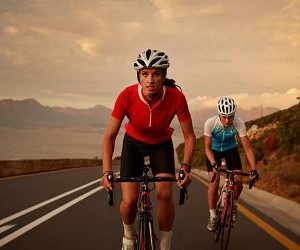Learn how to deal with punctures on long rides with prevention tips, repair techniques, and smart gear choices to keep rolling without stress.
HOW DO I PREVENT CRAMPS IN HOT WEATHER CYCLING?
Cycling in hot weather pushes the body to its limits, and one of the most common problems riders face is muscle cramping. Cramps can strike suddenly, turning a smooth ride into a painful struggle. Fortunately, they are preventable with the right approach. This article explores the causes of cycling cramps in hot conditions and offers proven strategies involving hydration, nutrition, training, and recovery. By the end, you’ll know how to manage your body’s needs so you can ride farther, faster, and without the pain of mid-ride cramps.

Understanding cramps
Before learning how to prevent cramps, it’s essential to understand why they happen, especially in hot weather cycling. Cramps are sudden, involuntary muscle contractions that typically occur when muscles are fatigued or when electrolyte and fluid balances are disrupted. The heat intensifies these risks, making summer rides particularly challenging.
Causes of cramps
Muscle cramps can be triggered by several factors, including dehydration, electrolyte imbalances, poor conditioning, or overexertion. In hot weather, sweat loss accelerates the depletion of sodium, potassium, and magnesium—key electrolytes responsible for muscle contraction and relaxation. Without proper replenishment, the nervous system sends faulty signals, leading to painful spasms.
Hot weather risk factors
High temperatures increase core body heat, making riders sweat more. Prolonged rides in the heat exacerbate fluid loss, which not only causes cramps but also raises the risk of heat exhaustion or heat stroke. Riders who are not acclimated to hot climates or who neglect pre-ride hydration are at even greater risk.
Dehydration accelerates electrolyte loss.
High-intensity efforts in the heat strain muscles faster.
Inadequate conditioning increases vulnerability.
Poor pacing disrupts muscle endurance.
By recognizing the root causes of cramps, cyclists can take preventive measures rather than simply reacting when spasms occur. Knowledge is the first line of defense against hot-weather cramps.
Hydration and nutrition
Staying hydrated and properly fueled is the single most effective strategy to prevent cramps while cycling in hot conditions. Your body is an engine, and in the heat, it needs the right fluids and nutrients to keep working smoothly. Small lapses in hydration or nutrition can trigger cramps during long rides.
Hydration strategies
Cyclists should start hydrating before the ride begins. Aim to drink 500–700 ml of water or a sports drink in the hour leading up to your ride. During the ride, consume 500–1000 ml of fluid per hour depending on intensity and temperature. Electrolyte drinks are superior to plain water in hot conditions because they replace sodium and other minerals lost in sweat. Carrying two bottles—one water, one electrolyte mix—is a practical approach.
Nutrition for cramp prevention
Nutrition plays an equally vital role. Carbohydrates provide the fuel muscles need to contract efficiently. Eating 30–60 grams of carbohydrates per hour during rides keeps energy levels stable. Equally important are minerals such as sodium, potassium, magnesium, and calcium, which regulate muscle function. Bananas, nuts, leafy greens, and sports gels are all excellent sources. A post-ride meal rich in protein and electrolytes accelerates recovery.
Drink fluids consistently before, during, and after rides.
Use electrolyte mixes rather than plain water in extreme heat.
Consume balanced snacks rich in carbs and minerals.
Refuel with protein and electrolytes after riding.
Cyclists who focus on hydration and nutrition dramatically reduce their risk of cramps. Proper fueling not only prevents painful spasms but also improves overall endurance and performance under the sun.
Training and recovery
Beyond hydration and nutrition, long-term strategies such as conditioning, pacing, and recovery play a crucial role in preventing cramps. Hot-weather cycling challenges both physical endurance and mental discipline, so riders must train smart and respect their body’s limits.
Acclimation and conditioning
Acclimating to heat gradually allows the body to adapt. Begin with shorter rides in warmer conditions and slowly extend both duration and intensity over 7–14 days. Building overall endurance with consistent training reduces the likelihood of cramps, as stronger muscles are less prone to fatigue-induced spasms.
Pacing and technique
Cyclists often cramp because they push too hard, too early in hot conditions. Smart pacing conserves energy and reduces stress on muscles. Use a cadence-friendly gear, avoid sudden sprints, and listen to your body’s signals. Riding within your aerobic zone for most of your training ensures that you have reserves for longer distances.
Recovery practices
Post-ride recovery is critical for preventing cramps in subsequent sessions. Stretching helps maintain flexibility, while foam rolling reduces muscle tightness. Adequate sleep and active recovery days allow muscles to repair and adapt. Adding mineral-rich recovery drinks or meals enhances replenishment after demanding rides in hot conditions.
Acclimate gradually to hot weather.
Train consistently to build endurance.
Pace smartly during long rides.
Stretch, roll, and rest for recovery.
Training and recovery are the long game of cramp prevention. Riders who combine conditioning, pacing, and recovery develop resilience, making them better equipped to handle hot-weather challenges without succumbing to cramps.
By uniting hydration, nutrition, training, and recovery, cyclists can turn hot-weather riding from a cramp-filled nightmare into a rewarding challenge. Prevention requires foresight and discipline, but the payoff is freedom to ride further and stronger under the sun.
YOU MAY ALSO BE INTERESTED






